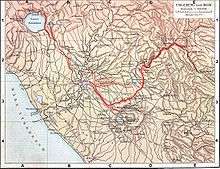List of aqueducts in the city of Rome
This page lists ancient Roman aqueducts in the city of Rome.

Introduction
In order to meet the massive water needs of its huge population, the city of Rome was supplied with 11 aqueducts. Their combined capacity was capable of supplying at least 1,127,000 cubic metres (nearly 300 million gallons) of water to the city each day mostly from the Anio and the Apennine Mountains, serving a million citizens. Detailed statistics for the city's aqueducts were logged around 97 AD by Sextus Julius Frontinus, the curator aquarum (superintendent of the aqueducts) for Rome during the reign of Nerva. Less information is known about aqueducts built after Frontinus.
These estimates may not have considered water loss. Modern engineers have questioned the validity of these figures and measured Anio Novus limestone deposits to estimate the average wetted perimeter and surface roughness corresponding to only 2/3 of the flow figure given below.[1]
Table
| Name | Year begun | Year completed | Length (km) |
Height at source (m) |
Height in Rome (m) |
Average gradient (%) |
Capacity (m³ a day) |
|---|---|---|---|---|---|---|---|
| Aqua Appia | 312 BC | 312 BC | 16.5 | 30 | 20 | 0.06 | 73,000 |
| Aqua Anio Vetus | 272 BC | 269 BC | 64 | 280 | 48 | 0.36 | 176,000 |
| Aqua Marcia | 144 BC | 140 BC | 91 | 318 | 59 | 0.28 | 188,000 |
| Aqua Tepula | 125 BC | 125 BC | 18 | 151 | 61 | 0.51 | 18,000 |
| Aqua Julia | 33 BC | 33 BC | 22 | 350 | 64 | 1.32 | 48,000 |
| Aqua Virgo | 19 BC | 19 BC | 21 | 24 | 20 | 0.02 | 100,000 |
| Aqua Alsietina | 2 BC (disputed) | 2 BC | 33 | 209 | 17 | 0.59 | 16,000 (not drinkable) |
| Aqua Anio Novus | 38 AD | 52 AD | 87 | 400 | 70 | 0.38 | 189,000 |
| Aqua Claudia | 38 AD | 52 AD | 69 | 320 | 67 | 0.37 | 184,000 |
| Aqua Traiana | 109 AD | 109 AD | 33 | - | - | - | |
| Aqua Alexandrina | 226 AD | 226 AD | 22 | - | 50 | - | 120,000 to 320,000 |
References
- Sturgeon, Clair; Shidlauski, Kristina (2015). "Illinois team solves ancient Roman water supply mystery". CEE. Department of Civil and Environmental Engineering, University of Illinois at Urbana-Champaign. Fall 2015: 24.